Sunrise can be a beautiful time at the pier!
Public Pier — No Fishing License Required
Looks, whether for women, men, or piers, can be deceiving. When first built, the expectations for this pier were high. It was similar to the expectations about the Ocean Beach Pier in San Diego which was seen as sort of a second coming if you listened to the talk of the fishermen at the time. Poking out into the Point Loma kelp beds, anglers expected to haul in the same fish as the sportfishing boats—at a fraction of the cost. It never happened. Expectations were never quite THAT high at this pier but many anglers, including myself, certainly expected it to be a bonanza of a pier. So far, it hasn’t happened!
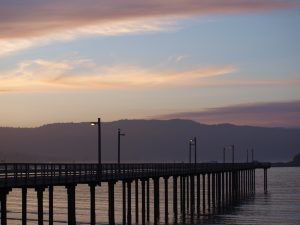
Time has proven the pier to be excellent for crabs but generally only poor to fair for fishing unless you happen to visit when a school of pelagic species is present. Even so, the view is absolutely breath taking (when it isn’t raining or foggy) and it’s satisfying to simply cast out a line and contemplate the beauty of the angler’s world. After all, catching a fish is only one aspect of pier fishing!
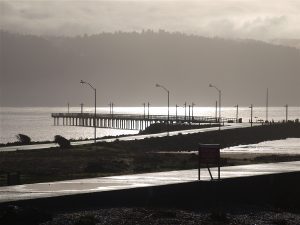
Environment. This 900-foot-long (some sources say 720 foot-long) pier is located at the western end of the bay almost directly opposite from Citizen’s Dock, its sister (brother?) pier to the east. Nearby, to the west, sits the city’s jetty/breakwater (with its famous tetrapods) and the Battery Point Lighthouse.
The bottom here is mud and sand, but the pier’s closeness to the breakwater, and several fairly good size rocks/small islands that sit near the pier, would seem to offer a combination of conditions ideal for both sand and rock seeking species. However, the rocky shore species such as greenling, cabezon and rockfish prefer the truly rocky areas (i.e., the jetty at Whalers Island) and the surf species, like redtail surfperch, generally prefer the nearby coastal beaches.
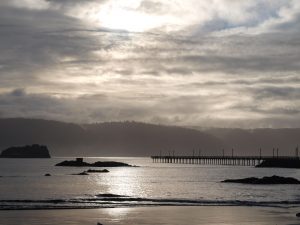
The pier does sit in a fairly straight line from the entrance to the bay and it does, at times, offer up good fishing for the transient schools of fish that enter the bay—the smaller surfperch, jacksmelt, herring, and, in warm water years, schools of jack mackerel. It can also offer the chance for salmon, especially when schools of baitfish such as anchovies are using the bay as home. On the bottom, it sees some flatfish as well as a few sharks, skates and rays. But overall, the fishing is fairly slow and inconsistent.
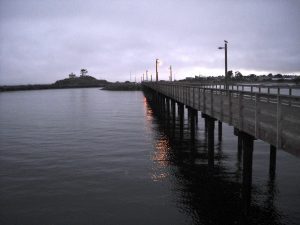
Not so with the crabbing that is good much of the year. Most of the crabs are Dungeness crabs although a few red crabs also show up. Since Dungeness can only be kept legally for part of the year be sure to know your regulations (season, size and method of take).
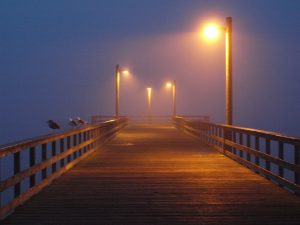
The early morn’ hours as well as night-time hours can be special at the pier; sometimes when the fog moves in there is almost an ethereal feeling to the pier. Just make sure you bring some warm clothing since that fog can also seem to cut to the bone.
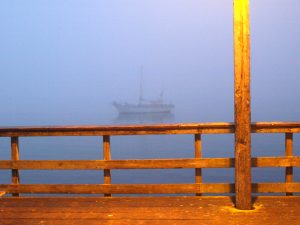
Ghost ship?
Unfortunately there just doesn’t seem to be a lot of attractants for fish. Even the pilings are wrapped in rubber, a preventive “new century” technique used for their protection. One result of the rubber wrapping is that pilings are void of the mussels that help transform many piers into virtual artificial reefs. There are a few acorn and goose barnacles on the pilings but little else. What the pier seems to need is an artificial reef similar to those that have been installed at many piers to the south.
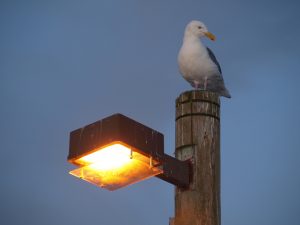
One aspect that should not be overlooked is the weather. Yes, the city gets five and a half feet of rain each year but that’s generally during the winter months. And yes, although it rarely is cold, it is cool most of the year. But for anglers, wind can be as bad or worse than rain and this pier sees a lot of wind. The pier sits just a fairly short distance from the main jetty and the ocean and there is little to block the wind when it comes up. Unfortunately, that seems to occur many if not most afternoons and evenings.
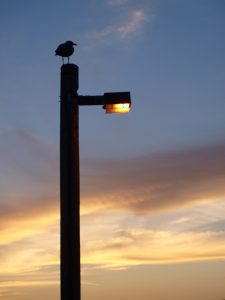
On my trips to Crescent City I seem to often arrive mid-day and I usually fish first at Citizens Dock. Often I have planned to fish at the B Street Pier during the evening in hopes of latching onto a big skate, a leopard shark or a bat ray since the pier has the requisite sandy/muddy bottom for those species and they bite best during the evening hours. Often too I have given up due to the high winds and biting chill. Mornings are normally calm but the nighttime hours remind me of the Berkeley Pier at night (which often calls for arctic-like clothing).
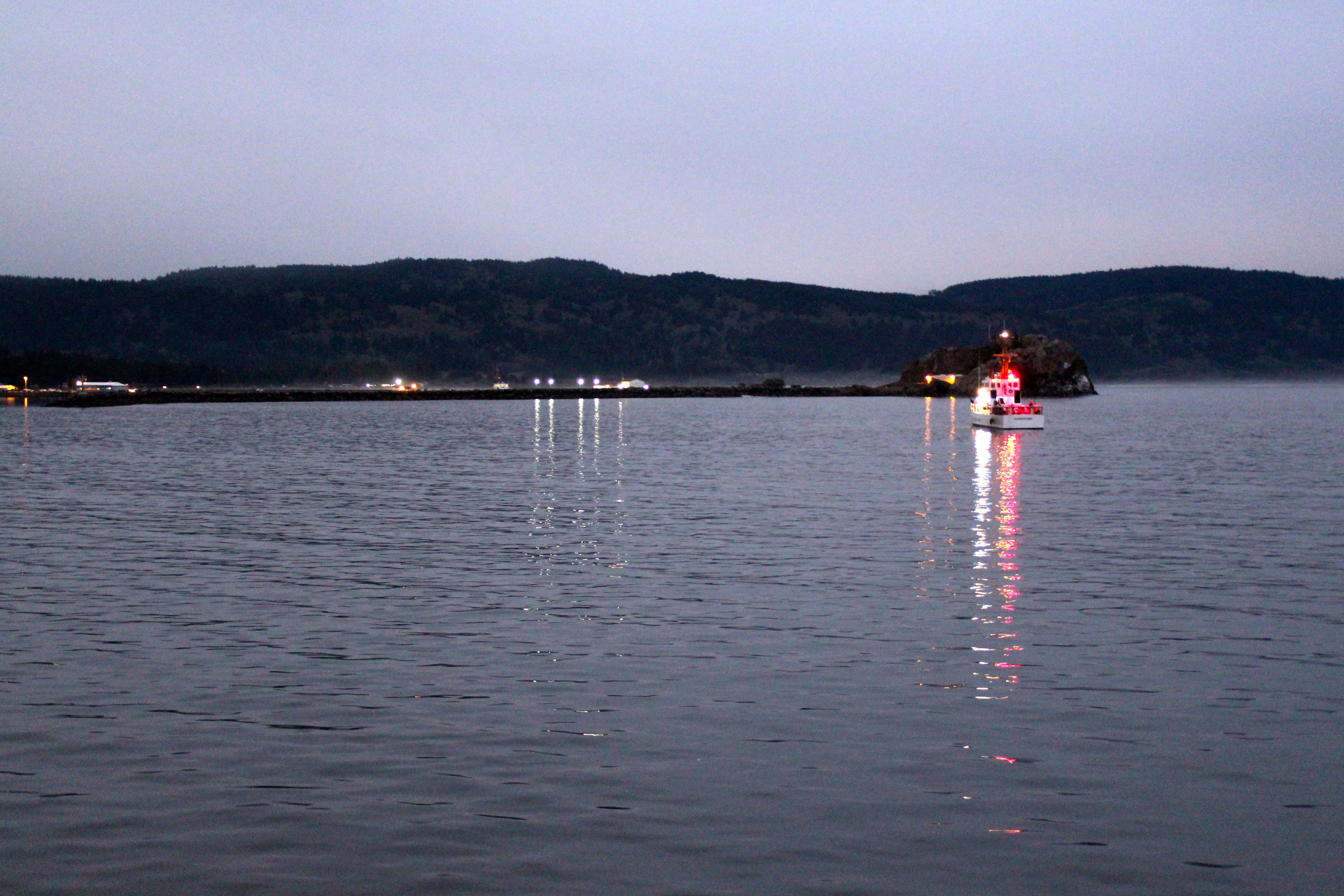
As example, a visit in 2015 saw me decide to walk out on the jetty prior to fishing at the pier. The jetty can be a dangerous place, which sign after sign proclaims. On a calm day it can be good for fishing but on a rough day the waves can be breaking over the top. This late afternoon visit saw waves breaking over the jetty at the end but it appeared safe to walk part way out. I was hoping to get some pictures of the pier from a different angle (which I did) but it was a costly visit.
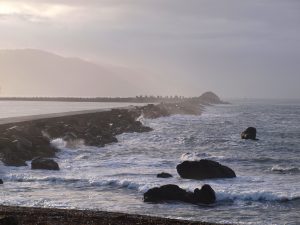
The wind was strong and the stinging sand was hard on the face; it reminded me of a visit to an acupuncturist more than twenty years ago. Luckily, I had a warm jacket and my “Wylies Malibu Bait Shop” hat but the hat was soon to be gone. I found out that I needed to lean into the wind and try to hold my hat but that didn’t work when I needed to take a picture and, as said, the hat became a victim of the wind (RIP old friend). When water started coming onto the jetty where I was standing, I decided it was time to move inshore. I’m sure if people had been watching it would have reminded them of the pictures of wind-blown reporters during a hurricane (and asking themselves how dumb is that?). Luckily, I always carry extra hats when I’m on my fishing trips.
Given the ferocity of the wind, and the fact that my hands felt frozen, I decided that fishing would be impossible. Sometimes you have to punt! In this case I headed back to my motel and dreamed of what might have been.
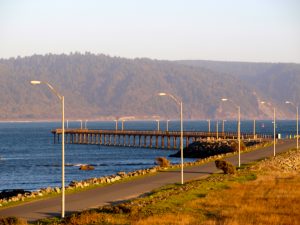
The next morning the wind had abated (somewhat) and the waters around the pier were calm. The bay was filled with anchovies, I caught some for live bait, and soon after caught a silver (coho) salmon. Looking back in my records, there were at least four times when I planned to fish the pier at night but gave up due to the wind.
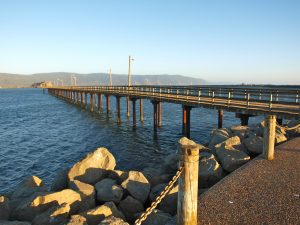
While doing research on the wharves of Crescent City, I ran across the following quote that seems as accurate today as then.
“The peaceful quiet of cool twilight is broken only by the sad cry of the moaning dove and the lazy lapping of the waves along the beach. Then from far out at sea comes a faint sound like the distant roar of a multitude of voices; it increases in depth and volume with every instant and from the north-west there sweeps a wild blast that gathers up the sands of the beach and drives them whirling along the shore. The surface of the water quivers for an instant as though struck by a mighty hand, then sends a succession of swelling waves that gather strength as they approach and break open the land.
Soon the whitecaps come rolling on from afar, running a race landward, bringing with them a flock of screaming gulls white as the foam itself, and whose erratic flight carries them through the hollow of the wave, and now vaulting upwards to the skies. There is a great commotion where the steep reefs extend out in the sea, for ponderous billows are rolling in upon them and crashing against their sides with tumult that is deafening.
The foam gleams pale in the gathering night as the breakers leap among the rocks; it streams down their drenched tides in a thousand tiny torrents and mingles with the restless surf that booms in upon the beach in ever increasing strength and fury. And so the day closes among whistling winds and driving clouds along these bleak and desolate shores.”
—Col. John L. Burns, Crescent City News, 1894
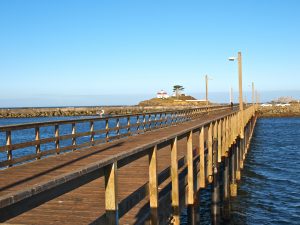
The pier does deserve its title as the ultima thule of California piers, the most northern pier in the state. Given that the state line with Oregon lies roughly 20 miles to the north, that fact should not be too surprising.
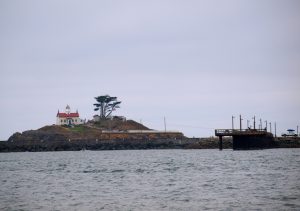
The pier and lighthouse
Fishing Tips. The predominant fish much of the year will be small to medium-size perch such as silver surfperch and walleye surfperch, staghorn sculpin, and small flatfish. Small hooks (size 4-8) baited with pieces of tube worms, shrimp, or clams take most of the fish. If schools are thick, you can try bait rigs like Sabikis (size 8-12), but they do not normally seem to take as many fish as at other piers.
Redtail and calico surfperch may make an appearance, especially around late May or June, and if they do the best bait will be sand crabs which you have brought from nearby beaches. Next best baits would be pieces of clams, shrimp or tube worms. A standard high/low leader with number 4 or 2 hooks will prove adequate for these perch. A few other perch species, especially white seaperch and striped seaperch may occasionally show up and the same baits and riggings will work with them.
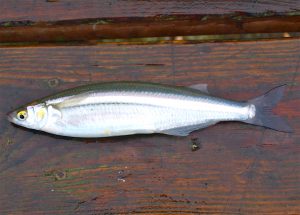
Topsmelt
Jacksmelt and topsmelt have proven to be a fairly common species and the typical rigging of 3-4 small size 8 hooks fished under a bobber seems to be the standard gear. Most anglers use small pieces of shrimp but I think pieces of tube worms make better bait. Although the large jacksmelt may be caught whenever a school swings past the pier, the prime time often seems to be at night, just as it is getting dark. Since the darkness can make it hard to see your bobber, buy one that is luminescent or buy a small hook-on glow light. The smaller topsmelt are rarely large enough to eat but make good live bait.
Flatfish have proven to be fairly common, something which was to be expected given the sand and mud bottom around the pier. Most prevalent are small speckled sanddabs that will latch on to bottom baits and hooks intended for larger fish. Unfortunately, most of these are really too small to keep for any useful purpose (although they might work as bait for a larger flatfish).
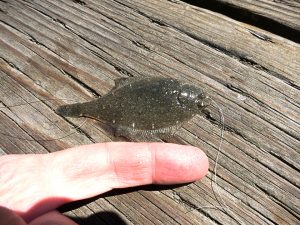
A really, really, really small speckled sanddab
Luckily, a few Pacific sanddabs and sand sole may also show up and they can be large enough to eat. Quite a few starry flounder also enter the bay and anglers with know how can catch a few of these tasty fish. Best rigging is a sliding leader rigging which offers no resistance when picked up by the flounder. Bait with a strip of anchovy, a piece or shrimp, clam, or tube worm. Although I haven’t seen any anglers use them here, I think live ghost shrimp would prove to be a sure fire bait for the bottom flatfish (as long as the crabs don’t get them first). You can’t buy ghost shrimp locally but I would think they would be available in the mud flats of the bay if locals acquired some ghost shrimp pumps.
Halibut have proven to be the game fish ‘de jour for most of the pier anglers. Most years see a few California halibut landed with fish in the 24-30 inch size being recorded (and a 29-pounder was caught off the pier in 1997). I haven’t heard of any Pacific halibut being caught but some of the young of the species should enter the bay. For both of these species, a sliding leader baited with small live bait would be best. This generally means a live shinerperch, or a small walleye or silver surfperch (and you might need to go over to the Citizen’s Dock to catch the bait). Sometimes schools of anchovies, smelt, herring or sardines may also swarm around the pier. Be sure you have some bait rigs with you so that you can snag some of the fish for live bait. Unusual has been the report of these halibut during the winter months (when the weather cooperates). Whereas December runs of the fish have been reported at this pier, most California piers see May-July as the prime halibut months.
This pier has lights so it can be fished at night—if the winds cooperate. This should improve your chances for skates, bat rays, or sharks if you wish to fish for them—but few do. Most of the sharks are leopard sharks or dogfish (sand sharks) although the numbers tend to be fairly low (perhaps due to a lack of anglers). There was a good run on large leopards in July of ’09 and a report of a blue shark landed at the pier but the overall lack of sharks is still somewhat of a mystery. Use squid as the bait for the sharays since it will best survive the ravages of the crabs.
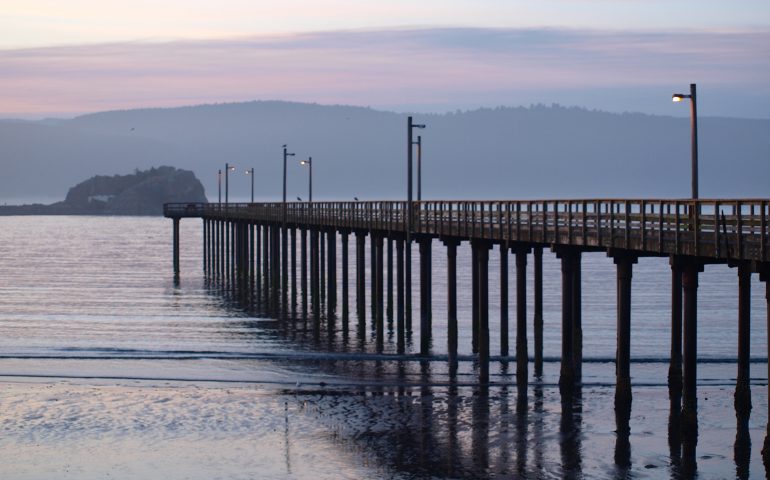
Pier was constructed in 1989 to my design. How’s the deck holding up?
All the sawn timber was fabricated, then treated per standard Coast Guard practice. This means the bolt holes were treated instead of raw and the sloped railing ends were also treated. Just wondering!